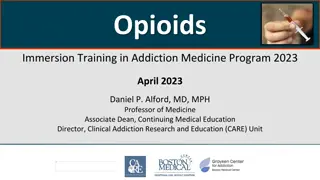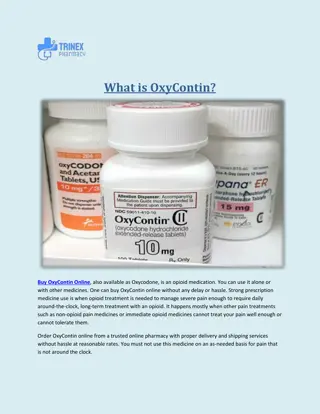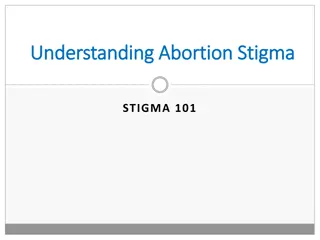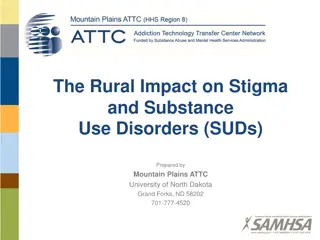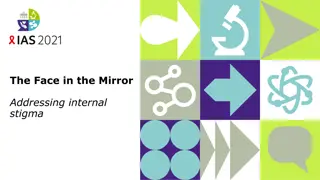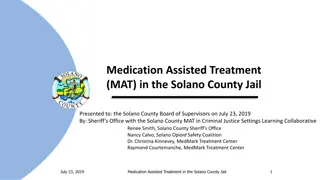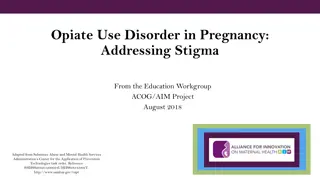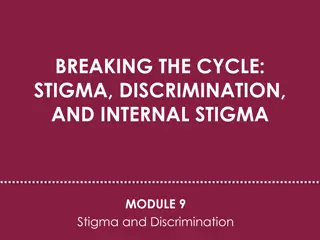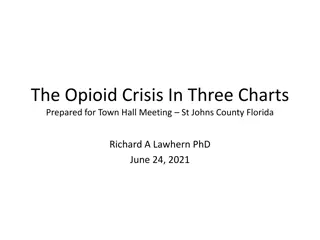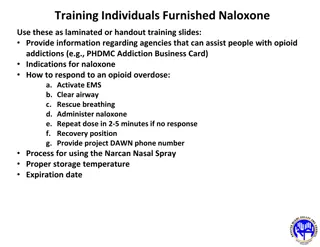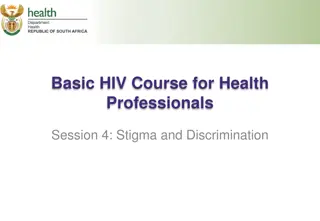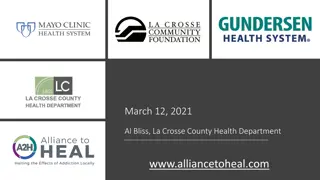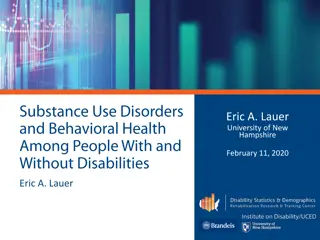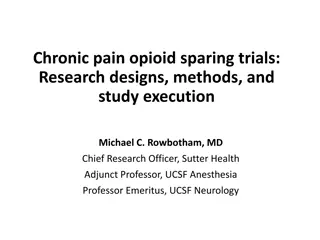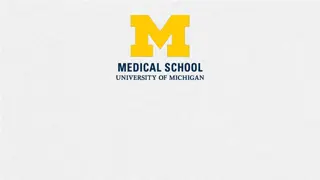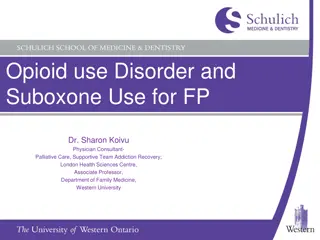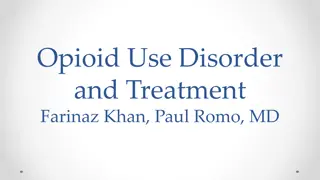Understanding and Addressing Stigma in Opioid Use Disorder Treatment Providers
This presentation by Dr. Jonathan Morrow highlights the stigma surrounding opioid use disorder treatment, focusing on identifying causes of stigma, using de-stigmatizing language, addressing stigmatizing behaviors, and reducing stigma at an institutional level. It discusses the types and effects of stigma, particularly from healthcare providers, and factors that influence clinicians' attitudes toward individuals with substance use disorders.
Download Presentation

Please find below an Image/Link to download the presentation.
The content on the website is provided AS IS for your information and personal use only. It may not be sold, licensed, or shared on other websites without obtaining consent from the author. Download presentation by click this link. If you encounter any issues during the download, it is possible that the publisher has removed the file from their server.
E N D
Presentation Transcript
Addressing Stigma in Opioid Use Disorder Treatment Providers Jonathan Morrow, MD, PhD Assistant Professor of Psychiatry University of Michigan Addiction Treatment Services (UMATS)
Learning Objectives Identify the main causes of stigma among substance use disorder treatment providers. Employ de-stigmatizing language and behaviors when treating patients with substance use disorders. Recognize and effectively address stigmatizing behaviors among colleagues. Formulate a strategy for reducing stigma at an institutional level.
What is stigma? Social stigma is defined as the dehumanization of an individual based on their social identity or participation in a negative or undesirable social category (Luoma et al 2010). External, public stigma Attitudes and reactions towards socially excluded groups From health care providers, law enforcement officers, families, communities Laws, regulations, cultural context represents structural stigma Internal, felt , self-stigma Experience of discrediting attributes result in devaluation, shame, stigma avoidance, fear of enacted stigma Rejection further increases marginalization
Effects of Stigma Decreased access Employment Housing Treatment Interpersonal relationships Negative self-image Mental health disorders Stress-related physical health problems Avoidance of treatment, employment, relationships, etc.
Health care providers as a source of stigma Health care professionals are the most commonly cited source of stigma for patients receiving treatment for substance use disorders (Luoma et al 2007). No other physical or mental illness is stigmatized more than substance use (Corrigan et al 2000; Crisp et al 2000). Effects of stigma tend to start in earnest when people enter treatment and are labeled within the health care system (Link et al 1989). Stigma is worst among seasoned clinicians (Avery et al 2017; Gilchrist et al 2011; Lindberg et al 2001). See SUD patients as unimportant, poorly motivated, manipulative, violent Leads to lower empathy, lower provider involvement, shorter visits, lower patient engagement and retention
Factors that worsen clinicians attitudes toward individuals with substance use disorders Clinical experiences primarily with individuals with severe substance use disorders Lack of exposure to individuals in recovery Lack of time and resources Poor role models and mentorship Perception of substance misuse as a moral failing
Theories About Addiction Addiction Is Primarily A Moral Problem Addiction Is Primarily A Spiritual Deficit Addiction Is Primarily A Character Disorder Addiction Is Primarily Poor Willpower Modern addiction experts teach that addiction is a biopsychosocial disorder.
Theories About Addiction Addiction Is Primarily A Moral Problem Addiction Is Primarily A Spiritual Deficit Addiction Is Primarily A Character Disorder Addiction Is Primarily Poor Willpower Modern addiction experts teach that addiction is a biopsychosocial disorder that is both preventable and treatable.
Solutions Speak up! Educate yourself, so that you can educate others. Treat people with dignity and respect. Don t give up on people. Don t define people by their disorder.
Dont say Instead say Addict User Substance or drug abuser Junkie Alcoholic Drunk Substance dependence Former addict Reformed addict Person with opioid use disorder (OUD)/SUD or person with opioid addiction Patient Person in recovery or long-term recovery Person with alcohol use disorder
Its not just semantics Compared to those in the "substance use disorder" condition, those in the "substance abuser" condition agreed more with the notion that the character was personally culpable and that punitive measures should be taken.
Dont say Instead say Clean/dirty Testing positive/negative (not) in remission or recovery (not) abstinent from drugs (not) drinking or taking drugs (not) currently or actively using drugs Frequent flyer Recidivist Person experiencing recurrence/relapse Treatment was not efficacious Patient failed treatment
Dont say Instead say Habit Substance use disorder Drug addiction Use (for illicit drugs) Misuse, use other than prescribed (for prescription medications) Opioid agonist therapy Medication treatment for OUD Pharmacotherapy Abuse Opioid substitution Replacement therapy
Consider potential reasons for the stigmatizing behavior Gaining or maintaining power over another person Fear of people they don t understand or who are different Ignorance - Rules change and some people truly don't understand that their actions are hurtful. Intentional - Some people take out their own frustrations on others. The culture of the workplace supports it Rules are not enforced - When rules aren't enforced, people assume they don't really matter.
Determine how to REACT Recognize that stigmatizing behavior should not be normal or acceptable anywhere. Explain organization and agency rules against stigmatizing behaviors. Act to report stigma if you or someone you know is a victim. Care for those being stigmatized and the stigmatizer without accepting the stigmatizing behavior. Turn to key friends and advisors who also believe that stigmatizing behaviors are wrong.
Specific strategies for dealing with confrontation Humor: Humor can dispel some of the tension that comes with confrontation. It can also disarm a person who is potentially going to become aggressive or confrontational. This comes naturally to some, and not to others. If this is your strength, embrace it. Self-Talk: To prepare yourself for the confrontation, practice what you are going to say and give yourself words of encouragement. Role play possible reactions of the person you will talk to. Include both positive and negative reactions. Assert Yourself: Act on what you know is right. Be frank, and use I language. I felt stigmatized when you ____________, (or when __________happened.) Will you please stop? I noticed that this patient or colleague felt this when you ___________. Did you know that? Avoid confrontation if you know it will cause more damage than good, but be sure to seek help from a supervisor or other trusted person to help you resolve the situation!
Changing the culture Insert a discussion about stigma into a meeting that is already ongoing. Pay attention to and respectfully correct the language you and others are using. Use I language when educating others. Generate conversations about stigma on a regular basis surrounding topics that people are familiar with such as media or news events. Organize a stigma prevention campaign. https://attcnetwork.org/centers/central-east-attc/product/anti- stigma-toolkit-guide-reducing-addiction-related-stigma
Overarching Principles for Cultural Change Make long-term commitments Attitudes, norms, values, and policies develop over many years Thus, to achieve lasting effects effects, effort must be sustained over time. Use multiple approaches Make components integrated - share the same or similar goals, objectives, themes, and principles. Use science - addiction treatment research and statistical and epidemiological data. Use research-based techniques - social learning, health communication, and behavior and attitude change theories
Communication Principles Get your facts straight. Inaccurate information will diminish your efforts and backfire. Develop your message - What would you say if you could only say one sentence? Be a great listener - Communication is a two-way street. Remain on message and be professional When challenged try not to correct the challenger, but restate your message, perhaps saying the same thing using different words. Admit it when you don t know - Prepare a list of individuals who can provide additional information.
Stigma Prevention Campaigns Identify a specific problem What is the specific aspect that you want to address? In what ways is it a problem? Who is being hurt by the stigma? Who is perpetuating the stigma? Be as specific as possible. Assess community readiness - Do other people share your desire for change? Identify potential partners Identify potential solutions - Brainstorm and think outside of the box. Identify potential challenges Have certain approaches been attempted before? If so, what happened? What might backfire?
Behavior Change Principles Identify immediate positive outcomes for the audience - How will they benefit? Establish and maintain a consistent message Saying the same thing over and over in different ways can be very effective Repetition is good Repetition can help get your point across Use multiple delivery methods e.g. emails, print media, signage, and face-to- face efforts Use opinion makers - Identify and recruit people who are respected by the target audience to help make your case. Establish modest goals - Use them as a foundation on which to build and expand further stigma prevention activities. Offer help- e.g. sources of information about addiction, resources for providing care, referral information, options for consultation
Prevention Goals for Treatment Programs Demystify Treatment Many people, including treatment providers, tend to focus on the adverse consequences of addiction. Providing detailed information about the phases, stages, goals, and objectives of treatment can demystify this process. Demystify Recovery Many people mistakenly believe that recovery is a yes/no or success/failure concept. Educate people about the complexity and dynamic nature of recovery. Humanize Recovery Demystify Relapse Relapse is undesired but common among chronic disorders, including addiction. Relapse does not represent treatment failure. It does not mean that a client has rejected or failed treatment. It does not mean that the treatment program has failed to provide treatment. Relapse is consdered an opportunity to examine and revise individual s recovery program Celebrate And Promote Success Evaluate program effectiveness by conducting outcome studies. Publish the studies in journals. Publicize the outcomes through public relations, community relations, and media events.
Main Takeaways Stigma is a major challenge for people with substance use disorders. Health care professionals often perpetuate and exacerbate stigma. It is important to set an example by treating SUD patients with respect and dignity. It is also important to point out and correct stigmatizing behaviors from colleagues. Cultural change is possible, but it takes time and concerted effort.



